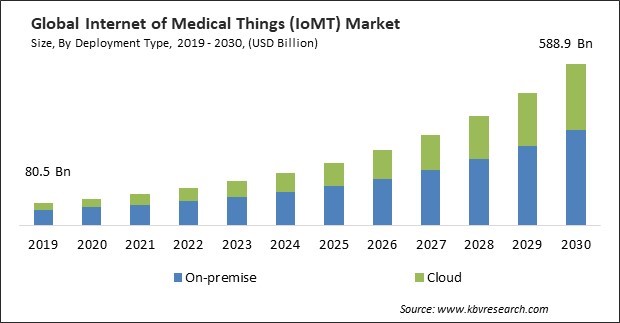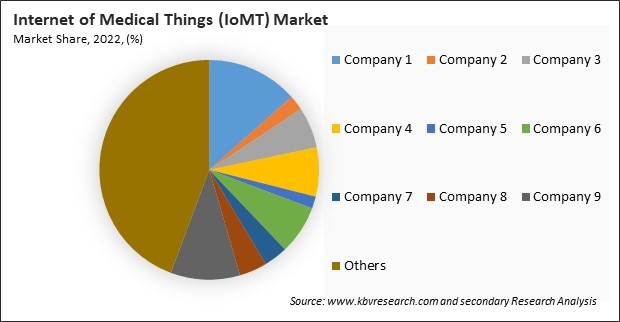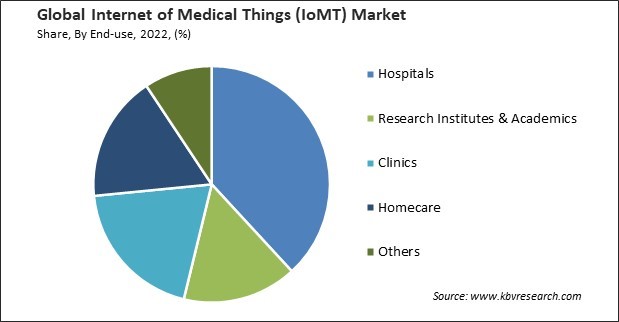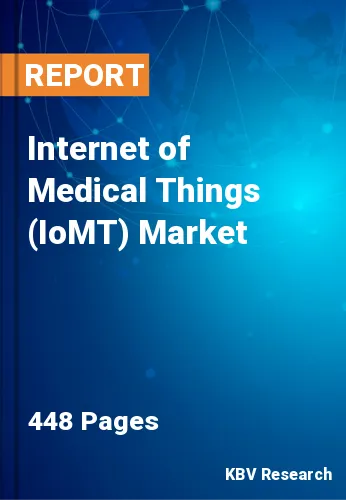The Global Internet of Medical Things (IoMT) Market size is expected to reach $588.9 billion by 2030, rising at a market growth of 20.4% CAGR during the forecast period.
Internet of Medical Things (IoMT) medication management refers to using connected devices and digital technologies to enhance medication prescription, dispensing, and monitoring. Therefore, the Medication Management segment will capture around 15% revenue share in the market by 2030. Medication management in IoMT offers numerous advantages, including increased medication adherence, personalized treatment plans, fewer errors, cost savings, and improved patient empowerment. Significant potential exists for IoMT to revolutionize medication management and healthcare as a whole as technology continues to advance. Some of the factors impacting the market are increasing connected device penetration, rising investments in healthcare IoT and Lack of infrastructure facilities and qualified specialists.

IoT Healthcare organizations' use of medical equipment and devices is revolutionizing medical care in novel ways. Connected devices such as ECG monitors, glucose monitors, blood pressure, and pulse oximeters are placed near a patient's body and provide round-the-clock medical assistance and services to increase customer satisfaction. IoMT devices connected to mobile apps allow continuous distant monitoring of critical signs, chronic conditions, and medication adherence. Mobile apps offer resources for health and wellness, including fitness routines, dietary guidance, mental health support, and stress management. Moreover, the Internet of Medical Things (IoMT) can decrease government and patient healthcare costs. With the Internet of medical things, MedTech companies are transforming advanced patient care delivery. During the pandemic, healthcare industry investments have increased significantly. The increasing investments in IoT to transform the healthcare industry are anticipated to expand the Internet of Medical Things (IoMT) market. Thus, the increasing adoption of connected device-based health solutions and rising investments in IoT in healthcare will increase, leading to market growth in the coming years.
Additionally, the COVID-19 pandemic severely impacted the global economy. The outbreak had either a positive or negative impact on nearly all industries. The initial months of the pandemic positively impacted the market. The pandemic accelerated the implementation of telemedicine and remote monitoring of patient solutions, which relied mainly on IoMT devices. Due to the reliance of the healthcare industry on connected devices, demand for IoMT rose during COVID-19, thereby accelerating the rate of technology adoption during the forecast period. Consequently, the market expanded substantially during and after the pandemic.
However, the lack of infrastructure facilities and qualified specialists is seen among various regions across the globe, directly impacting the market's growth. IoMT devices often come from different manufacturers and may use multiple communication protocols. This lack of standardization can hinder seamless integration and data sharing between devices and healthcare systems. The IoMT relies heavily on a stable and robust network infrastructure. In regions with limited internet connectivity or unreliable networks, the adoption and effectiveness of IoMT solutions can be hindered. Competing for qualified IoMT specialists in a competitive industry can be difficult for healthcare organizations. Additionally, retaining these specialists can be challenging as they may be in high demand. The lack of infrastructure, facilities and qualified specialists will hamper the market.

The leading players in the market are competing with diverse innovative offerings to remain competitive in the market. The above illustration shows the percentage of revenue shared by some of the leading companies in the market. The leading players of the market are adopting various strategies in order to cater demand coming from the different industries. The key developmental strategies in the market are Acquisitions, and Partnerships & Collaborations.
On the basis of component, the market is segmented into hardware, software, and services. In 2022, the hardware segment dominated the market with the maximum revenue share. This is due to the increased utilization of IoT-enabled medical devices. Components are designed to support multiple connectivity options, including Bluetooth, cellular, Wi-Fi, and low-power wide-area networks (LPWAN). This adaptability allows for seamless transfer of data to healthcare systems and mobile applications, which is predicted to propel segment growth over the forecast period.
Under hardware, the market is further divided into wearable devices, stationary devices, implantable devices, and others. In 2022, the stationary devices segment held the highest revenue share in the market. This results from the growth of wireless communication technologies such as Wi-Fi, Bluetooth, and LPWAN, which have enhanced connectivity options for stationary IoT devices. In addition, the government's initiatives to increase the adoption of medical devices play a significant role in the growth of digitally based medical device product sales.
On the basis of end-use, the market is segmented into homecare, clinics, hospitals, research institutes & academics, and others. The homecare segment acquired a substantial revenue share in the market in 2022. This growth is attributable to consumers' increasing desire to receive treatment for various diseases in the comfort of their residences. Enhanced disposable income, awareness of hospital-acquired infections, and consumer spending on health and wellness products and services are the main factors driving the segment's expansion.

Under software, the market is further classified into device management, application management, cloud management, data analytics, and others. The cloud management segment recorded a remarkable revenue share in the market in 2022. Cloud management is essential because it provides a scalable and secure platform for accumulating, storing, analyzing, and managing healthcare data generated by various medical devices and sensors. It permits secure data storage, real-time monitoring, analytics, and seamless incorporation of IoMT devices into healthcare workflows.
Based on deployment type, the market is fragmented into on-premise and cloud. The cloud segment covered a considerable revenue share in the market in 2022. This growth is attributable to the advantages offered, such as scalability and flexibility, which drive organizations and healthcare providers to employ IoMT solutions. This flexibility is essential for effective, cost-effective healthcare services, driving the segment's growth.
By application, the market is classified into telemedicine, clinical operations & workflow management, connected imaging, medication management, inpatient monitoring, and others. The inpatient monitoring segment projected a prominent revenue share in the market in 2022. Inpatient monitoring facilitates promptly identifying deteriorating health conditions, allowing healthcare professionals to provide medication and prevent adverse outcomes. This timely intervention improves patient outcomes and reduces hospital readmissions, which is anticipated to fuel the growth of the inpatient monitoring segment over the forecast period.
| Report Attribute | Details |
|---|---|
| Market size value in 2022 | USD 135.7 Billion |
| Market size forecast in 2030 | USD 588.9 Billion |
| Base Year | 2022 |
| Historical Period | 2019 to 2021 |
| Forecast Period | 2023 to 2030 |
| Revenue Growth Rate | CAGR of 20.4% from 2023 to 2030 |
| Number of Pages | 448 |
| Number of Table | 680 |
| Report coverage | Market Trends, Revenue Estimation and Forecast, Segmentation Analysis, Regional and Country Breakdown, Market Share Analysis, Companies Strategic Developments, Company Profiling |
| Segments covered | Component, Deployment Type, Application, End-use, Region |
| Country scope | US, Canada, Mexico, Germany, UK, France, Russia, Spain, Italy, China, Japan, India, South Korea, Singapore, Malaysia, Brazil, Argentina, UAE, Saudi Arabia, South Africa, Nigeria |
| Growth Drivers |
|
| Restraints |
|
Region-wise, the market is analysed across North America, Europe, Asia Pacific, and LAMEA. In 2022, the North America region held the highest revenue share in the market. This expansion is attributable to the region's developed telecommunications, enhanced IT infrastructure, robust and well-established healthcare facilities, and increased internet penetration. In addition, an increase in consumer spending on healthcare, a rise in disposable income, and an increase in disease prevalence all contribute to a growing demand for healthcare goods and services, driving the regional market's expansion.
Free Valuable Insights: Global Internet of Medical Things (IoMT) Market size to reach USD 588.9 Billion by 2030
The market research report covers the analysis of key stake holders of the market. Key companies profiled in the report include Apple, Inc., Boston Scientific Corporation, Biotronik SE & Co. KG, Cisco Systems, Inc., General Electric Company, Honeywell International, Inc., IBM Corporation, Koninklijke Philips N.V., Lenovo Group Limited and Medtronic PLC
By Deployment Type
By Component
By End-use
By Application
By Geography
This Market size is expected to reach $588.9 billion by 2030.
Increasing connected device penetration are driving the Market in coming years, however, Lack of infrastructure facilities and qualified specialists restraints the growth of the Market.
Apple, Inc., Boston Scientific Corporation, Biotronik SE & Co. KG, Cisco Systems, Inc., General Electric Company, Honeywell International, Inc., IBM Corporation, Koninklijke Philips N.V., Lenovo Group Limited and Medtronic PLC
The Hospitals segment is generating the highest revenue in the Market by End-use in 2022; thereby achieving a market value of $213.2 billion by 2030.
The On-premise segment is leading the Market by Deployment Type in 2022; thereby, achieving a market value of $348.1 billion by 2030.
The North America region dominated the Market by Region in 2022 and would continue to be a dominant market till 2030; thereby, achieving a market value of $209.4 billion by 2030.
Our team of dedicated experts can provide you with attractive expansion opportunities for your business.

